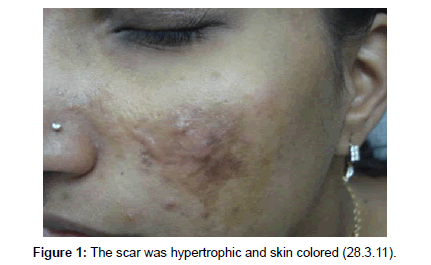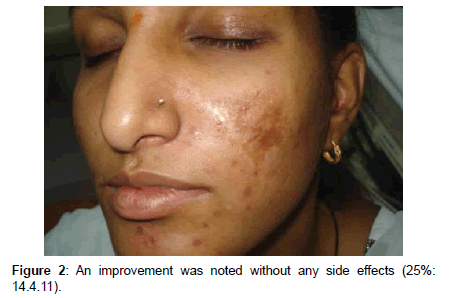Case Report Open Access
Treatment of Posttraumatic Scar with Ablative Fractional Erbium: YAG Laser
Venkataram* and Elizabeth P George
Consultant Dermatologist in Department of Dermatology, Mysore, India
- *Corresponding Author:
- Venkataram
Consultant dermatologist in department of dermatology
Venkat Charmalya-Centre for Advanced Dermatology
Mysore-560 040, Karnataka, India
Tel: +91 96118 42627
E-mail: dermadoc17@yahoo.com
Received date: September 08, 2015; Accepted date: January 04, 2016; Published date: January 07, 2016
Citation: Venkataram, George EP (2016) Treatment of Posttraumatic Scar with Ablative Fractional Erbium: YAG Laser. Cosmetol & Oro Facial Surg 1:104. doi:10.4172/jcofs.1000104
Copyright: © 2016 Venkataram, et al. This is an open-access article distributed under the terms of the Creative Commons Attribution License, which permits unrestricted use, distribution, and reproduction in any medium, provided the original author and source are credited.
Visit for more related articles at Cosmetology & Oro Facial Surgery
Abstract
Scars following injuries are common and an important cause of concern to patients. They can be treated with various modalities including lasers. Recently, fractional lasers have emerged as an effective, safe modality in tackling this challenge. There are limited publications on the efficacy and safety of treatment of post trauma scars with fractional ablative laser. Here we are presenting a case of posttraumatic scar treated with fractional ablative erbiumyag laser which showed significant improvement in colour, texture and overall appearance of the scar.
Keywords
Scar; Laser; Post trauma scar; Fractional Erbium-YAG laser
Introduction
Scars following trauma [1] is a cause of concern for many a patient. Various modalities have been used for the treatment of scars over the years. Corticosteroids, dermabrasion, surgical revision, chemical peeling, silicone gel application, pressure therapy, and radiation have been used with varying results [2]. Ablative lasers such as the carbon dioxide (CO2), erbium: yttrium-aluminum-garnet (Er:YAG), and pulsed dye (PDL) lasers have been tried in traumatic scars [2] and nonablative lasers have also been used [3]. The fractional technology is a novel strategy which safely improves the appearance of scars [1].But there are limited studies to support this fact [3].
Case Report
A 23 year old female patient presented in our clinic with a scar over left cheek. She had incurred it after a fall from a tree. There was no history of any surgery or burns. On examination, the scar was hypertrophic and skin colored (Figure 1). She had tried various topical medications for it but none of them helped her. She was advised fractional laser for her problem .After counseling her on the nature of her condition, treatment options, possible side effects, treatment outcome in detail, an informed consent was taken and objective analysis was done with photography. The procedure was repeated at an interval of 3 weeks till significant outcome. The response of treatment was assessed by a visual analog scale by an independent observer and also patient self-assessment.
The scar was cleaned. Topical anesthetic was applied for a period of 20 minutes to minimize pain. Patient’s eyes were protected. A fractional ablative laser namely 2940-PIXEL Erb: YAG Harmony Alma laser, was used for treatment using long pulse, with 49 matrices, starting at an energy of 1200mj and 6 stackings (Figure 1). The patient was asked to come after 3 weeks and the clinical improvement and side effect profile was assessed. An improvement of 25% was noted without any side effects (Figure 2). The energy was increased by 100mj in the subsequent sessions up to 1400mj 10 passes stackings (Figure 3). A total of 7 sessions was performed. The scar improved by 80% after about 7 sessions (Figure 4).
Discussion
Lasers are gaining popularity in the treatment of scars. Ablative lasers such as co2 and erbium yag were found to be associated with increased incidence of side effects and prolonged recovery period. To overcome the risks associated with ablative lasers, nonablative 1320 Ndyag and 1450 diode were introduced but they were limited in their efficacy .They produce a controlled thermal injury in the dermis followed by neocollagenesis and remodeling. To resurface scars, minimizing side effects the fractional lasers were introduced [4,5].
Fractional lasers constitute one of the revolutionary changes in the field of lasers. They offer the best of both worlds. They combine the efficacy of ablative lasers and the better side effect profile of non-ablative lasers. The concept of fractional photothermolysis (FP) was introduced by Mann stein and his colleagues. Light is emitted in a pixilated fashion creating an array of microscopic columns of thermal injury referred to as micro thermal zones [6]. These columns are incorporated with epidermal dermal debris which is then eliminated by Trans epidermal elimination. The surrounding normal tissue repopulates the columns of micro thermal injury producing quick healing and decreasing the downtime. Such fractions are treated over multiple sessions until complete treatment [7-10]. Scars can also be treated with fractional lasers. They improve the texture, quality and pigmentation of the scars. The 1540nm erbium glass has been used in the treatment of post traumatic scars [11]. These scars also respond to fractional lasers combined with ablative and non-ablative lasers producing complete to near complete resolution.
Nonablative FP uses near infra-red energy which spares the epidermis [12]. Ablative fractional lases induce cytokines and growth factors [1].
The ablative fractional erbium: YAG 2940 nm creates micro thermal zones followed by trans epidermal elimination, neocollagenesis and collagen remodeling.
Jung et al. demonstrated how ablative fractional CO2 is effective and safe in the treatment of early thyroidectomy scar [1]. According to Nouri et al, a nonablative laser such as PDL used in early treatment of scar decreases the erythema, hypertrophy and contraction of scars [13]. Choe et al. used a 1550 erbium glass laser for total thyroidectomy patients [14]. Further studies are needed to evaluate the effect of fractional lasers on post trauma scars and their mechanism [15]. To the best of our knowledge there have been no reports on the efficacy and safety of ablative fractional erbium: YAG laser for the treatment of posttraumatic scar and this is the first report on such an attempt.
They can be associated with various complications especially fractional ablative lasers. Transient effects include mild erythema, edema and peeling [16]. Aggressive use produces petechiae, persistent pigmentation, acneiform eruption, bacterial infections, cicatricial ectropion and hypertrophic scarring [17-21]. The patient in concern did not develop any such complications.
Conclusion
Fractional ablative lasers are thus found to be an effective, safe modality for the treatment of posttraumatic scars. Further larger, comparative studies are required to establish the effect of fractional ablative lasers in the treatment of posttraumatic scars.
References
- Jung JY, Jeong JJ, Roh HJ, Cho SH, Chung KY, et al. (2011) Early postoperative treatment of thyroidectomy scars using a fractional carbon dioxide laser. Dermatol Surg 37: 217-223.
- Conologue TD, Norwood C (2006) Treatment of surgical scars with the cryogen-cooled 595 nm pulsed dye laser starting on the day of suture removal. Dermatol Surg 32: 13-20.
- Park GH, Rhee DY, Bak H, Chang SE, Lee MW, et al. (2011) Treatment of atrophic scars with fractional photothermolysis: short-term follow-up. J Dermatolog Treat 22: 43-48.
- Tanzi EL, Alster TS (2004) Comparison of a 1450-nm diode laser and a 1320-nm Nd:YAG laser in the treatment of atrophic facial scars: a prospective clinical and histologic study. Dermatol Surg 30: 152-157.
- Alster TS, Tanzi EL, Lazarus M (2007) The use of fractional laser photothermolysis for the treatment of atrophic scars.Dermatol Surg 33: 295-299.
- Manstein D, Herron GS, Sink RK, Tanner H, Anderson RR (2004) Fractional photothermolysis: a new concept for cutaneous remodeling using microscopic patterns of thermal injury.Lasers Surg Med 34: 426-438.
- Hantash BM, Bedi VP, Sudireddy V, Struck SK, Herron GS, et al. (2006) Laser-induced transepidermal elimination of dermal content by fractional photothermolysis.J Biomed Opt 11: 041115.
- Walgrave S, Zelickson B, Childs J, Altshuler G, Erofeev A, et al. (2008) Pilot investigation of the correlation between histological and clinical effects of infrared fractional resurfacing lasers. Dermatol Surg 34: 1443-1453.
- Trelles MA, Vélez M, Mordon S (2008) Correlation of histological findings of single session Er:YAG skin fractional resurfacing with various passes and energies and the possible clinical implications.Lasers Surg Med 40: 171-177.
- Hantash BM, Mahmood MB (2007) Fractional photothermolysis: a novel aesthetic laser surgery modality. Dermatol Surg 33: 525-534.
- Behroozan DS, Goldberg LH, Dai T, Geronemus RG, Friedman PM (2006) Fractional photothermolysis for the treatment of surgical scars: a case report.J Cosmet Laser Ther 8: 35-38.
- Hantash BM, Bedi VP, Chan KF, Zachary CB (2007) Ex vivo histological characterization of a novel ablative fractional resurfacing device.Lasers Surg Med 39: 87-95.
- Nouri K, Jimenez GP, Harrison-Balestra C, Elgart GW (2003) 585-nm pulsed dye laser in the treatment of surgical scars starting on the suture removal day.Dermatol Surg 29: 65-73.
- Choe JH, Park YL, Kim BJ, Kim MN, Rho NK, et al. (2009) Prevention of thyroidectomy scar using a new 1,550-nm fractional erbium-glass laser.Dermatol Surg 35: 1199-1205.
- Kim SG, Kim EY, Kim YJ, Lee SI (2012) The Efficacy and Safety of Ablative Fractional Resurfacing Using a 2,940-Nm Er:YAG Laser for Traumatic Scars in the Early Posttraumatic Period.Arch Plast Surg 39: 232-237.
- Metelitsa AI, Alster TS (2010) Fractionated laser skin resurfacing treatment complications: a review.Dermatol Surg 36: 299-306.
- Setyadi HG, Jacobs AA, Markus RF (2008) Infectious complications after nonablative fractional resurfacing treatment.Dermatol Surg 34: 1595-1598.
- Fisher GH, Geronemus RG (2005) Short-term side effects of fractional photothermolysis.Dermatol Surg 31: 1245-1249.
- Graber EM, Tanzi EL, Alster TS (2008) Side effects and complications of fractional laser photothermolysis: experience with 961 treatments.Dermatol Surg 34: 301-305.
- Fife DJ, Fitzpatrick RE, Zachary CB (2009) Complications of fractional CO2 laser resurfacing: four cases.Lasers Surg Med 41: 179-184.
- Avram MM, Tope WD, Yu T, Szachowicz E, Nelson JS (2009) Hypertrophic scarring of the neck following ablative fractional carbon dioxide laser resurfacing.Lasers Surg Med 41: 185-188.
--
Relevant Topics
- Blepharoplasty
- Bone Anchored Hearing Aids
- Chemical peel
- Cleft Surgery
- Congenital Craniofacial Malformations
- Cosmetic Facial Surgery
- Craniofacial Surgery
- Dental Orofacial Surgery
- Dentoalveolar Surgery
- Head and Neck Reconstruction
- Injectable Cosmetic Treatments
- Lip Reconstruction
- Mandibular Nerve Surgery
- Maxfax Surgery
- Maxillofacial Surgery
- Neck Liposuction
- Oral and Maxillofacial Surgery
- Oral Surgery Surgeon
- Orofacial Surgery Braces
- Pediatric Maxillofacial Surgery
- Rhytidectomy
- Sleep Apnea Orofacial Surgery
- Temporomandibular Joint Disorders
- Upper Jaw Surgery
Recommended Journals
Article Tools
Article Usage
- Total views: 13477
- [From(publication date):
June-2016 - Apr 11, 2025] - Breakdown by view type
- HTML page views : 12586
- PDF downloads : 891




